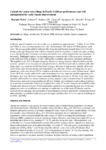Use este identificador para citar ou linkar para este item:
http://www.alice.cnptia.embrapa.br/alice/handle/doc/904115Registro completo de metadados
| Campo DC | Valor | Idioma |
|---|---|---|
| dc.contributor.author | MACHADO, P. L. O. A. | pt_BR |
| dc.contributor.author | COBUCCI, T. | pt_BR |
| dc.contributor.author | PACHECO, L. P. | pt_BR |
| dc.contributor.author | CASTRO, A. P. | pt_BR |
| dc.contributor.author | BARRIGOSSI, J. A. | pt_BR |
| dc.contributor.author | SILVA, J. G. | pt_BR |
| dc.contributor.author | WRUCK, F. J. | pt_BR |
| dc.contributor.author | MADARI, B. E. | pt_BR |
| dc.date.accessioned | 2011-10-26T11:11:11Z | pt_BR |
| dc.date.accessioned | 2011-10-26T11:11:11Z | pt_BR |
| dc.date.available | 2011-10-26T11:11:11Z | pt_BR |
| dc.date.available | 2011-10-26T11:11:11Z | pt_BR |
| dc.date.created | 2011-10-26 | pt_BR |
| dc.date.issued | 2011 | pt_BR |
| dc.identifier.citation | In: WORLD CONGRESS ON CONSERVATION AGRICULTURE, 5.; FARMING SYSTEMS DESIGN AND LANDCARE CONFERENCE, 3., 2011, Brisbane, Australia. Resilient food systems for a changing world. Brisbane: Australian Centre for International Agricultural Research, 2011. | pt_BR |
| dc.identifier.uri | http://www.alice.cnptia.embrapa.br/alice/handle/doc/904115 | pt_BR |
| dc.description | In Brazil, upland (rainfed) rice aka aerobic rice is planted on approximately 1.5 M ha. In the 1970s and 1980s, it was a common pioneer crop after deforestation with almost 4.5 M ha planted each year. The average grain yield of cultivars like Araguaia and Guarani ranged from 2.0 to 3.0 t ha-1, but the grain type (long and wide with low amylose content) resulted in a sticky rice after cooking. It was rejected by the consumers once long and slender, non-sticky irrigated rice was introduced in the market. Studies were initiated to tackle those problems, as an attempt to enable the cultivation of upland rice under ZT in acid tropical soils in the Brazilian Cerrado and Amazonia biome. Field experiments started for investigating the potential of modern upland rice cultivars at different row spacing to enable the use of the same ZT planter used for soybean (40-cm spacing), the interaction of seed chemical treatment and furrow compaction on rice plant mortality by termites in the early growth stages, and the effect of cover crops on mulching and soil NO3- and NH4+. Material and Methods | pt_BR |
| dc.language.iso | eng | eng |
| dc.rights | openAccess | eng |
| dc.subject | Aerobic rice | pt_BR |
| dc.subject | Furrow compaction | pt_BR |
| dc.title | Upland rice under zero tillage in Brazil: Cultivar performance and soil management for early vigour improvement. | pt_BR |
| dc.type | Artigo em anais e proceedings | pt_BR |
| dc.date.updated | 2011-10-26T11:11:11Z | pt_BR |
| dc.subject.thesagro | Arroz | pt_BR |
| dc.subject.thesagro | Oryza sativa | pt_BR |
| dc.subject.thesagro | Plantio direto | pt_BR |
| dc.subject.thesagro | Variedade | pt_BR |
| dc.subject.thesagro | Isoptera | pt_BR |
| dc.subject.nalthesaurus | Rice | pt_BR |
| dc.subject.nalthesaurus | No-tillage | pt_BR |
| dc.subject.nalthesaurus | Cultivars | pt_BR |
| dc.format.extent2 | 3 p. | pt_BR |
| riaa.ainfo.id | 904115 | pt_BR |
| riaa.ainfo.lastupdate | 2011-10-26 | pt_BR |
| dc.contributor.institution | PEDRO LUIZ OLIVEIRA DE A MACHADO, CNPAF; TARCISIO COBUCCI, CNPAF; LEANDRO P. PACHECO, UNIVERSIDADE FEDERAL DO PIAUÍ; ADRIANO PEREIRA DE CASTRO, CNPAF; JOSE ALEXANDRE F BARRIGOSSI, CNPAF; JOSE GERALDO DA SILVA, CNPAF; FLAVIO JESUS WRUCK, CNPAF; BEATA EMOKE MADARI, CNPAF. | pt_BR |
| Aparece nas coleções: | Artigo em anais de congresso (CNPAF)  | |
Arquivos associados a este item:
| Arquivo | Descrição | Tamanho | Formato | |
|---|---|---|---|---|
| wcca.pdf | 211.29 kB | Adobe PDF |  Visualizar/Abrir |









